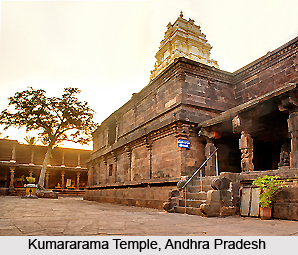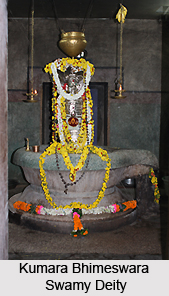 Temple of Kumararama is amongst the five `Pancharama Kshetras` which are dedicated to Lord Shiva, a Hindu deity, and this temple is also known as `Bhimarama Temple`. This Indian temple is situated in Samarlakota, East Godavari District in the southern Indian state of Andhra Pradesh. This pilgrimage spot is existent at a distance of nearly 1 km from the town of Samarlakota and about 10 km from Kakinada. The other temples belonging to the Pancharama Kshetras include Kshirarama and Palakollaund Somarama at the region of Bhimavaram, West Godavari District, Draksharama at Draksharama in East Godavari District and Amararama at Amaravati in Guntur District.
Temple of Kumararama is amongst the five `Pancharama Kshetras` which are dedicated to Lord Shiva, a Hindu deity, and this temple is also known as `Bhimarama Temple`. This Indian temple is situated in Samarlakota, East Godavari District in the southern Indian state of Andhra Pradesh. This pilgrimage spot is existent at a distance of nearly 1 km from the town of Samarlakota and about 10 km from Kakinada. The other temples belonging to the Pancharama Kshetras include Kshirarama and Palakollaund Somarama at the region of Bhimavaram, West Godavari District, Draksharama at Draksharama in East Godavari District and Amararama at Amaravati in Guntur District.
History of Kumararama Temple
The presiding deity of this temple is referred to as `Kumara Bhimeswara Swamy` and Bala Tripurasundari is the divine consort of Lord Kumara Bhimeswara Swamy. Local legendary tales have claimed that the Shiva Linga of this temple was established by Lord Kumaraswamy or Lord Shiva. Some of the significant festivals observed at the temple premises involve `Sarannavarathri`, `Maha Shivaratri` and `Kartika Masam`. There exists a regional legend which is related to the nomenclature of this area and the presence of Lord Shiva at this temple. According to this legendary account, the Shiva Linga which was inside the throat of `Tarakasura` had broken into five different pieces which had dropped at this region during the incident called `Tarakasura Vadha`. From that time onwards, the place came to be recognised as `Kumararama`. The son of Lord Shiva and Parvati, known as Kumara Swamy had installed Lord Bhimeswara Swamy and henceforth the temple is referred to as `Kumara Rama`. The temple exhibits a Dravidian style of architecture and was constructed by King Chalukya Bhima, therefore the temple is called `Bhimeswara`.
 Some recent excavations conducted in the temple grounds have revealed the existence of several figures which have been present over the last 1000 years. The Puranas state that the Kumara Rama Temple is an important `Yogakshetram` which implies that the temple can be accessed only by the devotees who have been granted the holy opportunity or `boon` or has been `fated to have` the chance to pay a visit to this temple. The Eastern Chalukya ruler named Chalukya Bhima I had created the temple in the latter part of the 9th century AD. The deity of Lord Shiva in the form of the divine Shiva Linga was named in the honour of Chalukya Bhimeswara. As per the inscriptions of the temple, the son of Vikramaditya named Chalukya Bhima had emerged victorious in the 360 wars, and had reigned for a period of 30 years. The architectural of the Bhimeswara Temple at Samarlakota bears a resemblance to the other Bhimeswara Temple which is based at Draksharama.
Some recent excavations conducted in the temple grounds have revealed the existence of several figures which have been present over the last 1000 years. The Puranas state that the Kumara Rama Temple is an important `Yogakshetram` which implies that the temple can be accessed only by the devotees who have been granted the holy opportunity or `boon` or has been `fated to have` the chance to pay a visit to this temple. The Eastern Chalukya ruler named Chalukya Bhima I had created the temple in the latter part of the 9th century AD. The deity of Lord Shiva in the form of the divine Shiva Linga was named in the honour of Chalukya Bhimeswara. As per the inscriptions of the temple, the son of Vikramaditya named Chalukya Bhima had emerged victorious in the 360 wars, and had reigned for a period of 30 years. The architectural of the Bhimeswara Temple at Samarlakota bears a resemblance to the other Bhimeswara Temple which is based at Draksharama.
Architecture of Kumararama Temple
The erection of Kumararama Temple began around 892 AD and it was finally accomplished in 922 AD. The Shiva Linga is composed of limestone and is white in colour. Kumararama Temple is present at a distance of 1 km from Samarlakota. The Shiva Linga measures about 16 feet in height and protrudes into the second floor by piercing sharply through the terrace, wherein `Rudrabhaga` is worshipped. 100 pillars lay the foundations of the temple `mandapam` and are architecturally superior. A bull figurine carved out from a single stone is present at the entrance of Kumararama Temple, which is referred to as the `Ekasila Nandi`. The compound of this temple is similar to that of the other Pancharama Temple located at Darksharama, another name for which is `Bhimeswara Alayam`.
Two grand `prakara` walls surround the temple which is manufactured from sand stones. A `gopura` entrance is present near the outer prakara wall. `Surya Dwaram` is the name of the main entrance of the Kumararama Temple. The walls of the temple are adorned with exquisite carvings of `Apsaras` on the temple pillars. A hundred pillars have been employed to support the `mantapam`, along with four `gopura` decorated with `ardha` on the `dvaras`. Two separate sections divided by a cornice is present inside the inner enclosure walls of the Kumararama Temple. The temple also consists of a pillared mandapa which is double storeyed and a mantap called `Koneti` on the eastern side of the temple. Devotees will be able to catch sight of the Koneru or Pushkarni Lake from the premises of the Kumararama Temple. The temple was remodelled during the period of 1340 till 1466, during the regime of the Kakatiya Dynasty; therefore the temple is enriched with architectural patterns which were a common architectural characteristic which was witnessed during the reign of the Kakatiyas and the Chalukyas. Bala Tripura Sundari is the Goddess who is also worshipped here.
Festivals Celebrated in Kumararama Temple
The daily ritual of `Abhisheka` is celebrated during the months of November to December, which is referred to as `Kartika` and `Margasira` months. `Utsavam` is the festival which is observed during `Kalyana Mahotsam`, which falls during `Magha Bahula Ekadashi` in the months of February to March. Great celebrations at held at the temple which continue till Maha Shivaratri. Rajahmundry, Thalupulamma Thalli, Draksharama and Annavaram are the other interesting places located close to the temple.
Visiting Information
Samarlakota is situated at a distance of nearly 125 kms from Vishakhapatnam , 15 kms from Kakinada, 40 kms from Annavaram and 49 kms from Rajahmundry. This area is based over the Vijayawada- Howrah railway line of the South Central Railway, from where travellers can avail a number of trains.





















